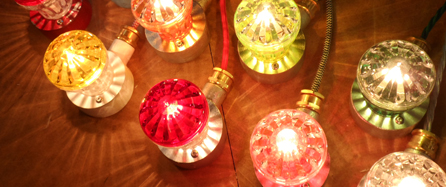
Fight fantastic: wWith demand for LED building contouring increasing in recent months Applelec has launched Borderline, a new LED tubing system which offers high brightness and is reportedly, ‘far more energy efficient’ than any glass neon system
There is no doubt that the LED sector is growing fast. My visit to Sign and Digital UK seemed to be punctuated by the fantastic brilliance of these little bulbs. At almost every turn, there they were, clamouring for my attention. So I decided to find out for myself just why everyone is so excited by them and whether they really do live up to the claims that are made for them.
Power to the people
LED technology is constantly evolving and improving, with greater light output and increasing efficiency, and the last twelve months have seen performance levels improving and prices falling. Adrian Dennis, sales and marketing director of Zeta Specialist Lighting, explains: “Increasingly LEDs are replacing traditional solutions due to their longer life and lower running costs; they also deliver a significant reduction in power consumption.”
Recent developments from Zeta include the Zeta Light Guide Panel for use in six-sheet advertising unit and the new Embedded LED Panel for back light-ing light boxes and totem illumination.

Combining solar and LED in signage solutions has come to the fore over
the last year. The two technologies together provide significant savings
on installation costs and ongoing considerable cost savings, as with
solar-powered solutions the running costs are zero”
Dennis continues: “Combining solar and LED in signage solutions has come to the fore over the last year. The two technologies together provide significant savings on installation costs and ongoing considerable cost savings, as with solar-powered solutions the running costs are zero. I believe this is a trend that is set to continue over the coming months and years, both in the UK and International signage sectors.”
Elsewhere, The Sign Group has seen a positive trend towards fairground style lighting where the light source is visible, and incorporates very bright LED modules.
“It seems the excitement of using cabochon lighting to recreate fair-ground style signs hasn’t dulled over the recent months, in fact quite the opposite,” enthuses director Ian Hoole, who adds: “Almost 25 percent of the signs we produce and an astonishing 40 percent of the components we supply are all fairground related; customers can’t get enough.”

The demand for cabochon lighting to recreate fairground style signs, where the light source is visible and incorporates very bright LED modules, shows no sign of abating for The Sign Group
He adds: “At some point the need for them will calm down and balance out, but when? There are lots of creative types thinking up new and unusual ways to incorporate retro lighting, so hopefully the desire for them will continue.”
The Sign Group has also seen its HB3 and VB3 modules become increasingly popular due to their high light output against low power usage.
“They do have to be used in the correct way due to their brightness, but they stand up against any other LEDs on the market for brightness, lifespan, ease-of-use, and price,” claims Hoole.
Building contouring is another growing sector and has resulted in new product developments from Applelec.
Business development manager, Andy Armitage, explains: “For years, glass neon was used to create illuminated building contouring, but over the last ten years or so this has fallen out of favour due to the high energy consumption of neon. However, as LEDs continue to evolve, they provide alternatives to an increasing range of lighting products, and building contouring is another addition.”
O Factoid: Appearing as practical electronic components in 1962, the earliest LEDs emitted low-intensity infrared light. Early LEDs were often used as indicator lamps for electronic devices, replacing small incandescent bulbs. Modern LEDs are available across the visible, ultraviolet, and infrared wavelengths, with very high brightness O
With demand for LED building contouring increasing in recent months, Applelec has launched Borderline, a new LED tubing system that offers high brightness and that the company claims is far more energy-efficient than any glass neon system.
Blinded by the light
When anything new comes onto our radar, it is easy to be carried along on the wave of excitement and enthusiasm that surrounds it, allowing ourselves to be totally blind to its true value. As with any technology, there are advantages and disadvantages to be taken into account when comparing LEDs with traditional lighting forms such as neon and fluorescent, with some diametrically opposed views coming into play.
Sign-Tec managing director, Graeme Browse, says there is potential for reduced maintenance with LED but those reductions are not as great as some claim. “Longevity is also often overstated,” he says.
He goes onto explain that while in some respects LEDs can be easier to install compared to neon, they are often being installed without an understanding of the technical aspects. Potential problems are therefore crea-ted, with poor arrangements of LEDs resulting in uneven lighting.
“We see this a lot,” says Browse, adding: “A lack of expertise in design to ensure good results, and also attempts to cut costs by using too few LEDs. We would advise customers to discuss projects with their suppliers and learn some of the basics before installing.”

Ian Hoole, director at The Sign Group, says:
“People sometimes see LEDs as the answer
to everything, and why not? They're low energy,
high output, low voltage and therefore very safe”
At the same time, Sign-Tec is currently seeing a significant resurgence in demand for neon for exposed installations. “Neon wins hands down for text and lettering, as light is transmitted from all directions,” affirms Browse.
Zeta’s Dennis takes a somewhat differing stance, arguing: “LEDs are rapidly replacing traditional lighting options and for very good reason. Traditional fluorescent lights have a life expectancy of 3,000 to 4,000 hours, whereas LED will last over 30,000 hours. This results in lower maintenance costs, lower power usage, and better looking signage.
“Further to this,” he continues, “while fluorescent tubes give 360 degree illumination, most signage solutions only require 180 degrees, which LED blade arrays provide perfectly. This means that energy is no longer being wasted illuminating areas unnecessarily and the end result is cleaner, brighter, and has less striping than the traditional solution.”
Looking at both sides of the ‘argument’, Hoole balances up the pros and cons: “LEDs are massively more economical than any of the traditional options, the only drawback being they can sometimes take slightly longer to fit. People sometimes see LEDs as the answer to everything, and why not? They’re low energy, high output, low voltage, and therefore very safe.”
Adding a note of caution, he continues: “While all of this is true, LEDs do have to be wired up correctly using the right wire gauge and connectors for the job. LED lighting is brilliant but can be potentially unsafe in the wrong hands. However, the likelihood of LED modules simply failing in the way that a fluorescent tube might, breaking like neon, or giving a static shock as can happen with exposed neon, is a million to one. And when it does happen it is more than likely to be down to how the LEDs have been fitted and wired in.”
Hoole continues: “There are simple steps to take whilst wiring up to ensure a safe job and we always offer this support and guidance to our customers.
“Having said all that, sometimes people just want the traditional look and feel of neon, which you can’t get from LED modules alone. However, by using our RetroNeon product that uses LED technology you can have the best of both worlds.”
It’s not easy being green
To quote the words of Kermit the frog, ‘It’s not easy being green’. So the 60 million dollar question is: are LEDs really a green solution?
Browse expresses concerns regarding disposal: “One big issue is not being addressed; there is currently no means available for recycling LEDs at the end of life. It’s ‘the elephant in the room’; manufacturers and suppliers are pushing longevity but not addressing the long-term event. For fluorescent and neon there are established recycling and waste disposal systems already set up and working, but these have not been put in place for LEDs.”
In terms of illumination, Browse says that while LED is quoted as an efficient light source, in fact the amount of light produced is not as good a quality as neon or fluorescent. He explains: “Although they give more lumens per watt, too few LEDs are often installed. At the end of the day the lumens/watt/cost ratio doesn’t stack up. LED signage works well if designed to use sufficient LEDs and they are positioned to give even illumination.”
Applelec’s LED Light Sheet was used to retrofit
signage for the Prince of Wales Theatre in London
where it replaced fluorescent tubes in a large
light-box, three projecting signs, and a door
streamer
The Sign Group’s Hoole approaches the issue from a different angle: “An average LED module gives a much higher output of light for the amount of energy put into it than most other types of lighting.
"Having said that, inexperienced users tend to think ‘more is better’ and LEDs get crammed into a space where possibly half the amount would have done.
"It will give a brighter light to a point, but it would be better to purchase a brighter module and use half the amount, which would cost less overall to purchase, and more than likely would result in lower running costs for the end-user.”
He adds: “We have guideline charts available for all the LEDs we supply, which give customers the perfect spacings to suit the style and depth of letters/lightboxes. This is aimed to give perfect illumination every time.”
Quality is high on the Applelec agenda and key to the ‘greenness’ of LEDs. Armitage summarises: “Many LED systems can be considered ‘green’ as they consume far less energy than comparable lighting solutions, whilst providing superior light output. However, as with most products, there are high- and low-quality options and whether an LED can be considered to be green depends on the quality or efficacy of the selected system.
“There are many cheap LEDs available across the marketplace and often these are energy inefficient with poor light quality and deceptive brightness levels, as over a short space of time the LED dims from its starting brightness; such systems are unlikely to be a green solution.”
Armitage continues: “It’s not too difficult to avoid poor performing LEDs though, as any respectable supplier will provide comprehensive data to help customers make decisions regarding the efficiency of the product they are purchasing. Suppliers that don’t provide this information, or provide patchy information, should be treated with caution.

This will be either as a result of cost-effectiveness or potentially even Government legislation, which was responsible for the demise of the traditional 60w light bulb”
”Taking a philosophical overview, Dennis concludes: “LEDs are certainly a ‘greener’ solution. They contain less harmful chemicals than fluorescent, have a longer life, use less energy, and have a lower disposal cost at the end of their life. Undoubtedly, the next few years will see further advances in LED technology, which will see price and performance improve further, and ultimately traditional solutions will cease to exist in our industry. This will be either as a result of cost-effectiveness or potentially even Government legislation, which was responsible for the demise of the traditional 60w light bulb.”
LEDs are clearly here to stay but, like most things in life, they may not always be what they seem to be and care needs to be taken in choosing a specific product and in designing the illumination for the finished sign. As for their environmental claims, I would say the jury is still out.
ENDS